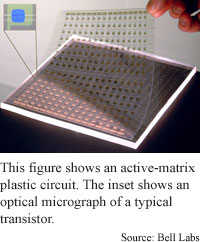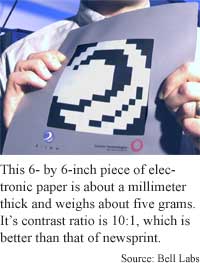
Prototype
shows electronic paper potential
By
Chhavi Sachdev,
Technology Research NewsComputers, someone said, will never replace newspapers because you can’t use a computer to swat a fly. This wry observation may not hold true for long, however.
Researchers at Lucent Technologies’ Bell Labs and E Ink have created electronic displays comparable to what the computer monitor was originally intended to replace: paper. So, in a few years, your electronic newspaper may be able to swat that fly and do everything a computer monitor can.
Real paper has all the characteristics electronic paper would like to emulate: low cost, flexibility, mobility, good image resolution, and contrast that doesn’t change with the viewing angle. Perhaps most importantly, paper does not require power in order to display text or images.
Researchers at Bell Labs have used plastic to create an electronic paper that is bendable, unbreakable, lightweight, low cost, and very low power. In short, it’s a reasonable stand-in for paper.
The researchers’ brand of electronic ink has been around since 1999, but the display itself has taken longer to evolve because the researchers chose to make it out of plastic. Because plastic cannot tolerate the high temperatures of silicon photolithography techniques, different processing and manufacturing techniques had to be employed, said John A. Rogers, director of Condensed Matter Physics Research at Bell Laboratories at Lucent Technologies.
The most common displays are the cathode ray tubes (CRT) found in boxy TV and computer monitors, and the liquid crystal displays (LCD) found in cell phones, wrist watches, laptops and personal digital assistants (PDAs).
While silicon circuits are made using photolithography, the gold film used for the electronic paper circuits is patterned using microcontact printing, an ultrahigh resolution form of rubber stamping, which is fast, continuous and efficient, according to Rogers. It is also cheaper than photolithography, he said.
“From a scientific standpoint there’s nothing particularly new” about the approach, said Vivek Subramanian, assistant professor of electronic engineering and computer science at University of California at Berkeley. “But what is interesting is how they’ve brought everything together, including E Ink’s system, to try to make a full system,” he said.
Two layers of plastic make up the display. One layer provides the optical contrast and the second layer houses the circuitry that controls images. Microcapsules of ink -- each one containing chips of white particles suspended in a black dye -- are sandwiched between the layers. The white particles congregate at the front or the back end of the microcapsule depending on the electric field generated by transistors in the plastic circuits.
Each transistor acts “as a voltage controlled switch [that] controls the color of the electronic ink pixels,” said Rogers. “When the particles are at the front of the display, the pixel appears white; when they are at the back, the pixel takes on the color of the dyed fluid in which the pigments are suspended -- black in this case,” said Rogers.
The black-on-white display can be made any size. The current model measures 6 square inches, is just under a millimeter thick, and weighs about five grams, or one tenth the weight of a thin film transistor (TFT) LCD of the same size, said Rogers. “For a backlit [liquid crystal] display with 6- by 6-inch viewing area, the power consumption is about seven watts,” he said. Electronic paper consumes about one thousandth as much power because it does not require backlighting and because the system is bistable, meaning no power is needed to display a pixel’s color, only to switch it, according to Rogers.
It is, however, low resolution, containing just 256 pixels compared to about 1.3 million in a standard 17-inch LCD.
In addition, although the transistors allow a switching speed of about 2.5 milliseconds, the total time for an image to change smoothly is about one second; typical LCD’s pixels are refreshed 70 times a second. “Currently the electronic ink, and not the transistors, limit the speed,” Rogers said. “The first applications of this technology might not require high speed operation,” he added. Devices such as PDAs and cell phones could work well even if refresh rates are as low as half a second, he said.
The electronic paper could also be used in everyday paper products such as newspapers, magazines and books. “An electronic newspaper…will consist of only one or a small number of sheets of electronic paper, onto which daily, or hourly, information content will be downloaded via a wireless connection to the Internet,” said Rogers. By the same token, cereal boxes, wall paper, and flyers could eventually be made from electronic paper.
“I don’t know if it will change electronic displays a whole lot because the pixels are too slow,” said Subramanian. Meanwhile, we continue to demand more from our electronics, he said. “I'd be surprised if they could do PDA displays without substantially improving their refresh rates. You need a refresh rate of about [17 milliseconds] to prevent flicker,” Subramanian said. “However, it would probably be adequate as a note-taking device or electronic book, since…the pixels hold their state once addressed,” he said.
Electronic paper displays could be in use within five years, Rogers said. The researchers are currently working on developing new transistor geometries and semiconductors that will improve the switching time. They also aim to speed up the refresh rate and to use the technology in non-display applications such as radio frequency ID tags that can replace bar codes, said Rogers.
Full motion video could also be possible with newer inks that change color more rapidly. “I think that this … will be possible within one to two years. The circuit part is, more or less, done already,” he said.
The printing methods for the circuits and the use of organic semiconductors make this research important, said Sigurd Wagner, a professor of electrical engineering at Princeton University.
Rogers’ colleagues were Zhenan Bao, Kirk Baldwin, Brian Crone, Anant Dodabalapur, Howard Katz, Valerie Kuck, and V.K. Raju at Bell Labs, and Karl Amundson, Jay Ewing, and Paul Drzaic at E Ink, Corporation. They published their findings in the proceedings of the National Academy of Sciences, April 24, 2001. The research was internally funded by Lucent Technologies and E Ink, Corporation.
Timeline: 3 to 5 years
Funding: Corporate
TRN Categories: Human-Computer Interaction; Integrated Circuits; Materials Science and Engineering
Story Type: News
Related Elements: Technical paper, "Paper-like electronic displays: Large-area rubber-stamped plastic sheets of electronics and microencapsulated electrophorectic inks," proceedings of the National Academy of Sciences, April 24,2001.
Advertisements:
May 23, 2001
Page One
Laser switch sets up logic
Light computer runs quantum algorithm
Five percent of nodes keep Net together
Prototype shows electronic paper potential
Lasers spin microscopic objects


News:
Research News Roundup
Research Watch blog
Features:
View from the High Ground Q&A
How It Works
RSS Feeds:
News
Ad links:
Buy an ad link
| Advertisements:
|
 |
Ad links: Clear History
Buy an ad link
|
TRN
Newswire and Headline Feeds for Web sites
|
© Copyright Technology Research News, LLC 2000-2006. All rights reserved.